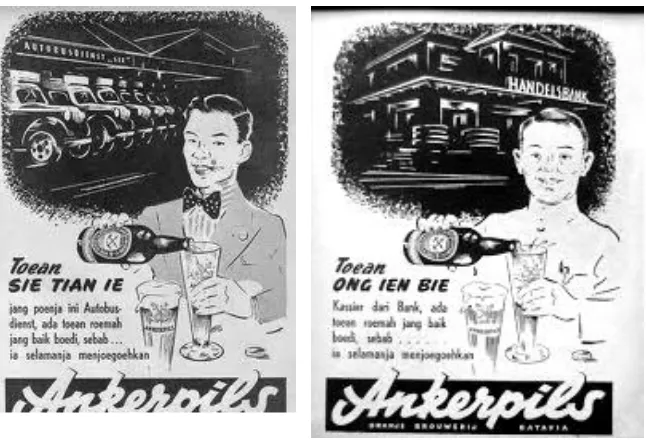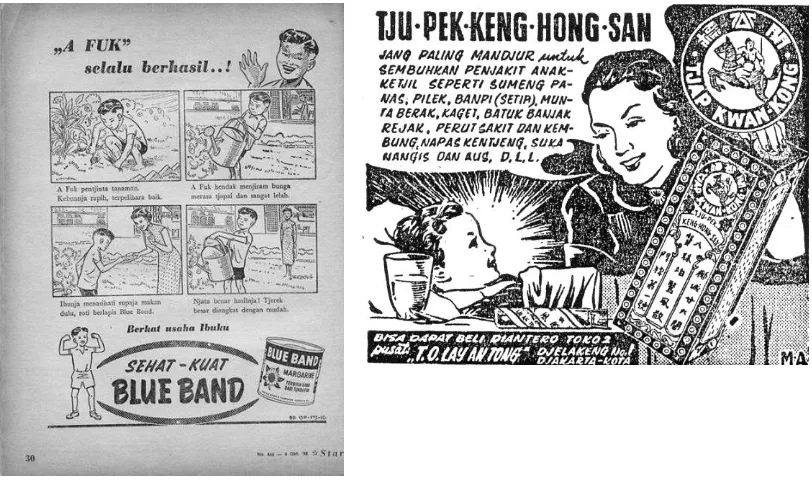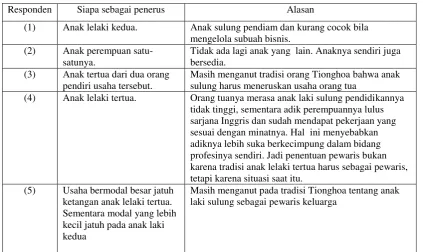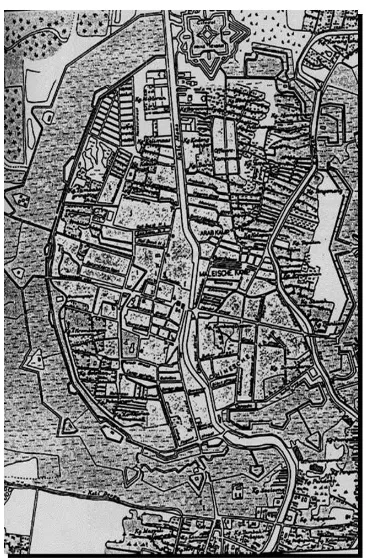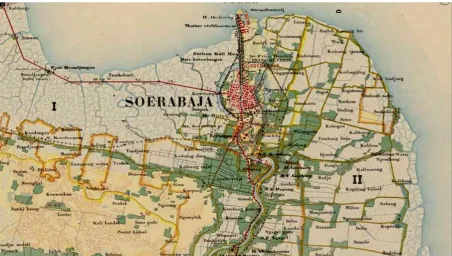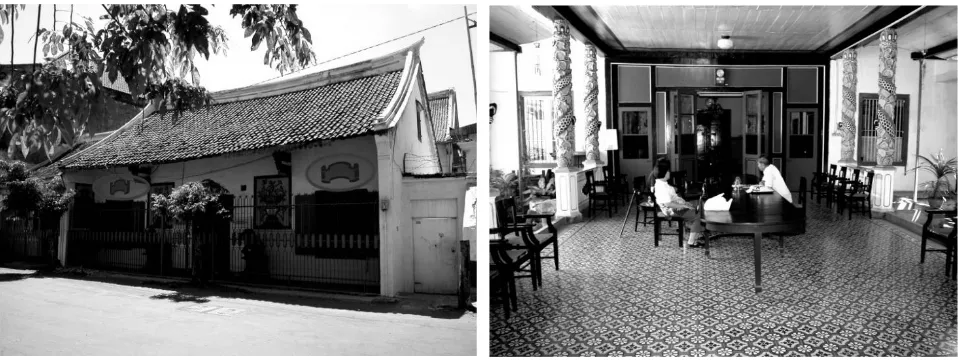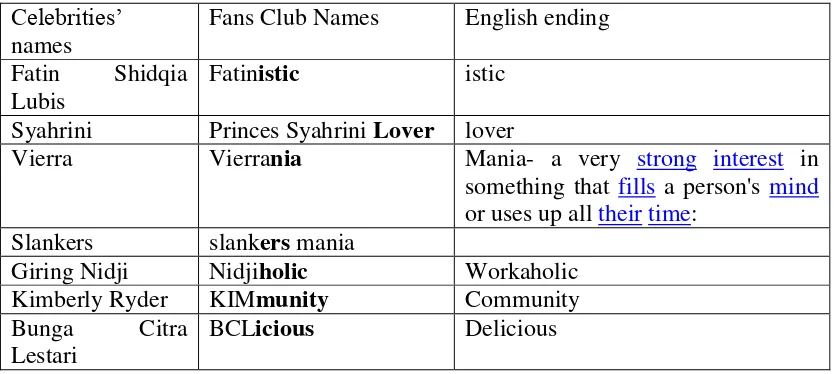Proceedings of International Conference on Chinese
–
Indonesians, Grand Candi Hotel, Semarang 14
–
16
November 2013
CHINESE
–
INDONESIANS :
THEIR LIVES AND IDENTITIES
Reviewers:
1.
Prof. Esther Kuntjara, Ph.D.
(Center for Chinese Indonesian Studies, Petra Christian University)
2.
Setefanus Suprajitno, Ph.D.
(Center for Chinese Indonesian Studies, Petra Christian University)
3.
Elisa Christiana, M.A., M.Pd
(Center for Chinese Indonesian Studies, Petra Christian University)
Published by :
Institute for Research and Community Service
Petra Christian University
Jl. Siwalankerto 121
–
131, Surabaya 60236
Indonesia
http://lppm.petra.ac.id
PROCEEDINGS OF INTERNATIONAL CONFERENCE ON
CHINESE
–
INDONESIANS : THEIR LIVES AND IDENTITIES
All rights reserved. No part of this publication may be reproduced, stored in a retrieval system, or transmitted, in any form or by any means, without the prior permission of the author.
©Center for Chinese Indonesian Studies, 2013
Cover design by Aristarchus P.K.
Published by:
Institute for Research and Community Service Petra Christian University
Jl. Siwalankerto 121-131, Surabaya 60236 Indonesia
http://lppm.petra.ac.id
i
PREFACE
This book contains the proceedings of the papers presented at the First International Conference on the theme of: Chinese Indonesians: Their Lives and Identities. This conference was held in Grand Candi Hotel, Semarang on November 14-15, 2013. The Conference was a joint collaboration of the Center for Chinese Indonesian Studies (CCIS) at Petra Christian University, Surabaya, as the organizing committee, with Maranatha Christian University, Bandung; Soegijapranata Catholic University, Semarang; and Xiamen University, Fujian, China.
For centuries, many Chinese who came to Nusantara have undergone various up and down experiences. They have been doing not only trading and sharing of their cultures with the local people, but their long stay in this country has also resulted in the intermarriages with the local people. At the same time they also had to deal with the Dutch, and later on with the Indonesian authority and their surrounding communities, in order to survive. Thus, they have eventually developed some hybrid cultures, which have been known as peranakan cultures. These hybrid cultures of the peranakan have later on become distinctive, which made the Chinese in Indonesia different in many ways with their ancestors in China.
The papers discuss on what it is for being a Chinese Indonesian. How have Chinese Indonesians perceived their Chineseness and their Indonesianness as their identities? The lives of Chinese Indonesians in building the economy, politics, literature, language and other domestic cultures like buildings and culinary have also been opted by the presenters here for discussion. All these various topics presented in this Conference were meant for discussion and further actions.
CCIS is very grateful for those who have participated in making the Conference a success. It is our hope that further thought and discussion could be carried out in the future along with the changing lives of Chinese Indonesians.
Thank you.
Surabaya, November 14, 2013
Prof. Esther H. Kuntjara, Ph.D.
ii
TABLE OF CONTENTS
PAGE PREFACE FROM THE ORGANIZING COMMITTEE ... i TABLE OF CONTENTS ... ii
1.Transformation of Indonesian Chinese Identity and Evolution of Chinese Newspaper in the 20th Century
Author : Shi Xueqin ... 1
2.浅析邦加岛客家文化区中元节的传承
(Analysis of Hungry Ghost Festival on Hakka Cultural District in Bangka Island Indonesia)
Author : Sugiato Lim ... 9 3.印尼华人李登辉缔造复旦的办学理念及其对当代印华教育的启示
Author : 周晔 ... 18
4.区域合作下的东南亚华商与中国
(Southeast Asia Ethnic Chinese Business and China in Regional Cooperation)
Author : 李一平 (Li Yiping) ... 28 5.Analisis Semiotika Terhadap Iklan Tempo Doeloe yang Ditujukan untuk Khalayak
Sasaran Orang Tionghoa
Author : Christine Claudia Lukman, Yasraf Amir Piliang, Intan Mutiaz ... 41 6.Sejarah Pers Tionghoa Makassar Hingga Menjelang Perang Dunia Ke-2
Author : Yerry Wirawan ... 53 7. Didik Nini Thowok: a Cross-Gender and Female-Impersonator Dancer Based in Java.
Considering the Construction of Identity
Author : Madoka Fukuoka ... 74 8.The Reception of The Young Chinese to the Television Shows on Imlek
Author : Liliek Soelistyo ... 83 9.Jaran Sampo, An Update and a Glance Into the Future
Author : Widjajanti Dharmowijono ... 89 10. Dari Kuli Kontrak Menuju Cina Kebon Sayur: Buruh Perkebunan Tionghoa di
Sumatera Utara dari Era Kolonial Sampai Sekarang
Author : Harto Juwono ... 99 11. Penentuan Suksesi Kepemilikan Usaha Komunitas Tionghoa Surabaya dalam Era
Globalisasi
iii
12. Ketika Oom & Tante Menjadi Susu’ & A’i, maka Pecinan menjadi Gangnam Style Author : Freddy H Istanto ... 125 13. Relevance of Peranakan Cuisine In Peranakan Identity Construction
Author : Hiang Marahimin ... 132 14. The Influence of Peranakan Tionghoa in Indonesian Culinary
(Ethnoculinary Indonesia – Tionghoa)
Author : Aji K. Bromokusumo (陈贵福) ... 142 15.Menyantap Soto Melacak Jao To
Author : Ary Budiyanto, Intan Kusuma Wardhani ... 153 16.The Effect of Colonialism on the Identity of this Chinese-Indonesian
Author : Lian Gouw ... 167 17. Chinese Indonesian Experiences in Chinese Indonesian Literature as World Literature:
Reading Richard Oh and Lian Gouw’s Novels
Author : Purwanti Kusumaningtyas ... 171 18. Chinese Language in Indonesia: Its Position as a Foreign and Heritage Language
Author : Julia Eka Rini ... 192 19. Strukturalisme Seni dan Filosofi Keabstrakan Kaligrafi China di Luar Pemahaman
Bahasa
Author : Elizabeth Susanti B.A, M.Ds ... 205 20. Tionghoa Dungkek dan Pulau Sapudi (Pulau Madura) dan Makna Kubur Berbentuk
Perahu
Author : Ardian Cangianto ... 218 21. Wayang Cina di Jawa Sebagai Wujud Identitas Budaya Etnis Tionghoa di Jawa
Author : Dwi Woro Retno Mastuti ... 237 22. Cheng Ho-related Piety in Post-New Order Indonesia
Author : Ivana Prazic ... 263 23. Yin Yang, Chi Dan Wu Xing pada Arsitektur Kelenteng
(Studi Kasus Kelenteng Sebelum Abad 19 di Lasem, Rembang dan Semarang)
1
Transformation of Indonesian Chinese Identity and Evolution
of Chinese Newspaper in the 20
thCentury
(Draft)
Prof. Shi Xueqin
School for Southeast Asian Studies, Xiamen University Fujian Province, China,361005
Xqshi68@xmu.edu.cn
Chinese migration history and Chinese Community in Southeast Asia
Chinese has a long history of mass migration to overseas land which could be traced back to the late of 16th century. Historically, Chinese mass migration can be divided into following four phases
with respective characteristic.
The first Chinese Mass Migration to Southeast Asia (1600-1850): the Interplay of Trade and Migration
As being geographically inextricably linked by land and water as well as historically associated by trade, Southeast Asian region has been a major migration destination for people in Southern provinces of China, like Fujian and Guangdong. The first Chinese migration to Southeast Asia lasted roughly 200 years, which began at the early 17th century, ending in the middle of 19th century. The
first wave of Chinese migration to Southeast Asia was featured with the interplay of trade and migration, which immensely promoted Chinese migration to Southeast Asia and the formation of early Chinese community. Till to the middle of 19th century, Chinese Diaspora mainly concentrated
in Southeast Asian archipelagos and peninsula. According to Prof Zhuang’s estimation, roughly 1,500,000 Chinese Diaspora inhabited the Southeast Asia area at the middle of 19th century,
respectively 70,000 Chinese in Siam, 14,000-15,000 in Java, 150,000 in Borneo, 50,000 in British Malay peninsula and Straits settlements colony, 110,000-130,000 in Burma, and nearly 10,000 in the Philippine islands. 1
The Second Chinese Mass Migration (1850-1920): Coolie Trade and Chinese Diaspora
Middle of 19th century is a watershed of Chinese migration history. In 1842, Ching government was
forced to open to the western powers after first Opium War. Five coastal port-cities Guangzhou, Xiamen, Fuzhou, Ningbo and Shanghai became the first port-cities open to western countries, which deepened greatly western penetration in Southern China. Since 17th century, with European
trading company’s arrival in Southeast Asian archipelagoes and their overall exploitation in the area, huge demands for labor in mines and plantations industries were increasing, leading to the rampant human abduction in the coastal cities in Southern China and local people’s anger and chaos. After Second Opium war, Ching government signed the Peking Convention (1860), agreeing to a clause permitting Chinese to make emigration contract with British firms. France, Spain and the United States shortly received similar assurances by treaty, regulating the Chinese labor migration to western power’s colony. Furthermore, Ching government continued to negotiate with British and France, and signed a Convention to Regulate the Engagement of Chinese Emigrants by British and France subjects at Beijing in 1866, setting up procedures for licensing foreign emigration agencies at Chinese ports, under mutual agreement by foreign consuls and Chinese authorities. Shortly after, Ching government signed Burlingame Treaty with the Unites States in 1868, which was viewed as a watershed of Ching emigration policy by legalizing the rights of Chinese emigration. The mentioned-above treaties significantly promoted the Chinese labor mass migration to western colony in Southeast Asia region, North and South America as well as Australia continent, which
1 Zhuang guotu, The relationship between Overseas Chinese and China (Hua Qiao Huaren Yu Zhong
2
changed dramatically the distribution of Chinese Diaspora. A huge number of Chinese Coolies was transported to Cuba, Peru, Mauritius, Reunion, Australia as well as North America Continent. A study showed that the number of Chinese contract labor emigration was as high as 2.65 million from the middle of 19th century to the early of 20th century, which excluded the number of other
categories of Chinese emigration. 2 While Southern China provinces like Fujian and Guangdong
were still the main emigration areas, about 2.85 million Chinese immigrated to Southeast Asian region only during 23 years from 1876 to 1898. 3 In terms of geographical distribution, Southeast
Asia region was still the concentration spot of Chinese Diaspora. At the beginning of 20th century,
the number of Chinese Diaspora is about 4-5 million in Asia, American continent, African continent as well as Australia, while 90 % inhabited in the Southeast Asian region, according to Zhuang’s study.
Third Chinese Mass Migration (1920-1950): Chinese Women Migration Wave
The first half of 20th century witnessed the change of structure of Chinese mass migration, although
Chinese migrants still kept the Southeast Asia region as the desired destination. The third Chinese migration wave with the characteristic of spontaneous migration was motivated by short economic soar in Southeast Asia during the First World War. This is the turning point in the history of Chinese women migration to Southeast Asia. The census of British Malaya reveals during that period, the number of Chinese women migrants moved to The Straits Settlement increased grossly.4 Although majority of Chinese women were migrated as the status of dependency to join
the reunification with family, they initialized a new chapter of Chinese women migration to Southeast Asia in the term of amount. Motivated by the development of Chinese community in Southeast Asia and increasingly deepening interdependence between Chinese community and China, more and more Chinese women migrants who desired to make a living independently in Southeast Asia started to increase. According to Dr. Fan’s study on Chinese Women in Malaya, Chinese women migrant in Southeast Asia has been increasing since 1930s, and the majority was Chinese female migrant labor, roughly estimated about 190,000.5 In addition, it is worthy to note
that Chinese female teachers were also involved into the migration to Southeast Asia for the purpose of teaching Chinese in huaqiao school , which revealed the new transformation of women migrant structure. The multi-structure of Chinese women migrant opened another new chapter of Chinese women migration to Southeast Asia. Generally speaking, it was the first half of 20th century
especially the period of 1930s witnessed the climax of Chinese women migration to Southeast Asia, which has been dwindled steadily following the outbreak of the Pacific War, and finally fell into the bottom at the end of World War II and the foundation of People’s Republic of China.
Fourth Chinese Mass Migration (1978- ):New Chinese Emigrants and Change
Since the founding of PRC, the Chinese migration wave was discontinued as being the two reasons. On the one hand, Beijing government strictly forbade Chinese citizens to overseas, much worse, the overseas relations were degraded as stain by Beijing government. On the other hand, being a communist country, China was contained by most Southeast Asian countries, therefore the Chinese citizens were banned to enter the gate of Southeast Asian countries. Meanwhile, in order to fasten
2 Chen ze xian, Chinese Contract labor in 19th Century, (Shi Jiu Shi Ji Sheng Xing de Qi Yue Hua Gong Zhi), History Studies, Vol.1, 1963, Beijing, China.
3 Chen Han Sheng, Documentary Collection of Chinese Labor, Vol.1, Zhong Hua Shu Ju,1980, Beijing,
China.
4 For example, from 1934 to 1938, Chinese women migrated to Malaya was increasing, the number
was listed as following respectively: 35063 (1934), 40921(1935), 51522 (1936), 95911(1937) and 44993(1938), which shared the percentage of the total amount of Chinese migrants at the same period respectively about 38.18%, 31.99%,39.76%,46.65% and 53.43%. See Fan Ruolan, Immigration, Gender and Overseas Chinese Society: Studies on the Chinese Women in Malaya(1929-1941), Beijing: Zhongguo Huaqiao Chubanshe, 2005, P80.
5 Fan Ruolan, Immigration, Gender and Overseas Chinese Society: Studies on the Chinese Women in
3
the assimilation of Overseas Chinese into indigenous society, governments of Southeast Asia countries implemented various policies to promote the assimilation of Overseas Chinese community. Until to 1980, the number of Chinese Diaspora around world was roughly 20 million, the natural growth of overseas Chinese population greatly contributed to the increase of this number.
Chinese migration wave starts to activate again since the late of 1970s. Two reasons stimulated the new Chinese mass migration. Firstly, the change of immigration policies in the developed countries benefitted the Chinese migrants to the developed countries. Secondly, China began to implement reform and opening-up policy, removing the bans on Chinese emigration, which undoubtedly promoted the new Chinese mass migration. Generally, Chinese new migrants can be divided into three categories in this period.
The first category is Chinese student Diaspora. Since 1978, more and more Chinese students are eager to study abroad. According to the statistics issued by Education Department of China, from 1979-2007, there are totally 1.21 million Chinese students went to study abroad and majority of them favored to settle down after graduation, mainly in the North America. It is said only 319,700 returned back to China.
The second category is unskilled laborer migrants who went to abroad through legal or illegal ways. United States is the most desired destination of this group of Chinese labor migrants. Zhuang’s study shows that unskilled laborer from Fuzhou area is an important constituent of Chinese labor Diaspora in the United States. In recent 20 years, about 600,000 people from Fuzhou area migrated to United States. 6
The third category of new Chinese migrant is traders and businessman. With the economic growth of China and the economic engagement between China and other parts of the world, more and more Chinese go abroad and do trading business or investing. Especially Southeast Asia region, as being geographically closed with China, is favored by Chinese traders and investors.
It is worthy of noting that with the growth of China’s investment in the fields of infrastructure and minerals industries in the developing countries, quite a number of Chinese labors have been employed and moved to the countries where China’s company involved. Some of Chinese employees chose to continue to live in the foreign countries after projects have been completed. Thus, it is estimated since 1970 to 2008, the number of Chinese new emigrants has exceeded 10 million, including 1.6-1.7 million Hong Kong citizen and Taiwanese, more than 8 million new emigrants are from mainland of China.7 Zhuang also estimated, currently, the Chinese Diaspora has
increased to 45.43 million around the world, roughly 33.48 million Chinese Diaspora ( 73.5%) inhabit in the region of Southeast Asia.
The Characteristics of Indonesian Chinese Community
Formation of Indonesian Chinese community has been pushed and shaped by Chinese migration waves since 17th century, which was deeply characterized in the population, geographic
distribution, dialect groups, gender ratio and occupation structure.
6 Zhuang guotu, Motivies and Conditions of Emigration from Changle to U.S in Last 20 Years: A Field
Study, History of Overseas Chinese Studies, Vol.1, 2006, Beijing,China.
7 Zhuang guotu, Historical Changes in Number and Distribution of Overseas Chinese in the World,
4 1860-1930 ChinesePopulation in Netherland Indies
Year population year popilation
1860 221 438 1900 537 316 1880 343 793 1905 563 449 1885 381 751 1920 809 039 1890 461 089 1930 1 233 214
---Data Source:Volkstelling, 1935.
1930 Dialect groups of Indonesian Chinese
Provinces Outside islands Java Total
Hokkien 175 370 376 611 554 981 Hakka 125 548 75 188 200 736 Teochew 82 549 5263 87 812 Cantonese 96 252 39 878 136 130 Others 127 864 82 491 210 355 Total 607 583 582431 1 190 014
Data Source:Volkstelling, 1935.
1860-1930 Indonesian Chinese Population in Java/Madula and outside Islands
Year Java/Madula outside islands
Population % population % 1860 149 424 67 72 014 33 1880 206 931 60 136 862 40 1885 221 959 58 159 793 42 1890 241 111 51 218 978 49 1895 256 155 55 213 469 45 1900 277 265 51 260 051 49 1905 295 193 53 268 256 47 1920 383 614 48 425 425 52 1930 582 411 47 652 783 53
Data Source:Volkstelling, 1935.
The cities or regions where Indonesia Chinese concentrated in 1930 Batavia(71688),
5 Sulawesi (41000),
Bali&Lombok( 11000), Maluku (9000), Eastern Islands( 6800)
Chinese tradition migration waves also shaped gender ratio and occupation structure of Chinese community in Indonesia.
1880-1930 Gender ratio of Indonesia Chinese in West Kalimantan Year male female
1880 1000 583
1900 1000 671
1920 1000 722
1930 1000 744
Indonesian Chinese Occupation structure in 1930s Occupation outside islands Java
Raw material production 44.6% 9.1% Industry 19.4% 20.8% Transportation 2.6% 2.8% Commerce/trade 23.1% 57.6% Freelance/artist 1.1% 2.1% Government employee 0.7% 0.5% Others 8.5% 7.1%
Souce: W.J.Cator, The Economic Position of Chinese in Netherlands Indies.1936,
In the Indonesia Chinese community where sex ration has been severely skewed, male migrants were forced to marry indigenous women, which dramatically reshaped the Chinese community and produced a group of peranakan Chinese, the chinese group who was born in Indonesia.
Emergence of Chinese Newspaper in the early 20th Century
China’s political movement in the early 20th century awaked Indonesian Chinese national
consciousness and triggered the publication of Indonesia Chinese newspaper. Educated peranakan pioneered the publication of the newspaper in the Indonesia.
In the early of 1910s, peranakan Chinese published newspapers, advocating revival of Chinese culture and confucianism, like Li po (理报,1901) ,Pewa,rta Soerabaja (泗水新闻,1902), Warna Warta (综合新闻,1902) ,Chabar Perniagaan (商业新闻,1903),IK Po(译报,1904), Loen Boen(论 文,1904), Ho Po(和报,1904),Hari Sumatra( 苏岛日报,1904) .
During the period of early 20th century, Perannakan Chinese also published Malay newspaper such
as Djawa Tengah 中爪哇报(Semarong,1909), Tjahaja Timoer 东方之光(Surabaya,1914), Tjhoen Tjhioe春秋(Surabaya,1914), Asia亚洲(Semarong, 1921), Kong Po光报(Jarkata,1921),Bin Seng民 声报(Jakarta,1922), Keng Po竞报(Jakarta,1923), Sin Bin新民报(Bandung,1925).
Development of Chinese Newspaper
Undoubtedly Chinese publication has been deeply influenced by China’s political movement and rising nationalism in the early of 20th century. The founding of United League of China branch in
6
Bao>(Jakarta, 1909), <爪哇公报 Djarkata News>(Semarong,1909)<汉文新报 Han Wen
Sin Po>(Surabaya,1909)<苏门答腊报Sumatra Po>(Weekly,Medan1909) were motivated by Chinese nationalism, functioned as the propaganda organs of Chinese revolution parties. While these Chinese Newspaper were short-lived and little influence in Chinese community.
Since 1920s, the Sinkeh Chinese began to increase in large numbers, who were illiterate in Malay, in order to meet the need of Sinkeh Chinese, Chinese community started to publish Chinese newspapers, which promoted Chinses newspaper into a mushrooming period.
Firstly, Sin Po started to publish Chinese version in 1921, and followed by a series of Chinese nespaper such as <HarianSemarong 三宝垄日报,1925>,<Harian Makassar 锡江日报,1922》, 《Harian Bin Po全民日报》,三宝垄的《Harian Tiong Nan中南日报》,1927锡江的《Bin Seng
民声报》,1928泗水的《Daily Telegraphy爪哇每日电讯》《Surapaya Sin Po泗滨新报》,棉兰 的《Sin Tiong Hwa Po新中华报》,1929《荷属民国日报》和泗水的《侨声日报》.
Among these publication, Sin Po and Harian Thien Sung Yip Po became the influential newapapers in the Indonesia Chinese community, actively advocating Chinese nationalism. Sin Po paid huge attentions to affaires by taking Chinese nationalism stand. Ang Jan Goan (洪渊源), the President of Sin po and chief editor Tjoe Boe San (朱茂山) both are perannakan, they were representative of Indonesian Chinese community politically supported Chinese nationalism. While Harian Thien Sung Yip Po, which was an important propaganda organ of Chinese National Party branch in Jakarta, politically support National Party of China. Meanwhile, in Surabaya, Chinese nationalist began to publish newspaper Harian Tay kong Siang Po大公商报.
It is worthy of noted that two special Chinese groups emerged , one group was calledChung Hwa Hui, led by Jian Fuhui简福辉, who favored the Dutch colonial regime in Indonesia and advocated
to cooperate with Dutch by supporting Indonesia Chinese to naturalize Dutch citizen. They published Perniagaan (商报). Another group was Partai Tionghoa Indonesia led by Lin Qunxian
who politically supported Indonesian independent movement, advocating Indonesia Chinese to assimilate into Indonesia and to naturalize Indonesian citizen. They created their organ newspaper
Sin Tit Po (新直报).
The revival and conflict of Indonesian Chinese newspaper in the Post WWII
Chinese newspapers with patriotism were banned to publish during Japanese occupation . Indonesia Chinese newspaper moved to a new period of revival and thriving after the Japanese surrendered in 1945. While with the founding of People’s Republic of China in 1949, influenced by China’s politics and intensification of Cold War, the Indonesian Chinese community was divided into groups who were ideologically hostile to each other, resulting in the serious clash between newspapers of pro-Beijing and that pre-Taiwan.
Pro-Beijing Indonesia Chinese newspaper: Jakarta: Mingguan Seng Hwo Pao/ Seng Hwo Pao
Medan:<Sumatra Bin Pao苏门答腊民报> ,<民主日报>,<华侨日报>
Pontianak:<Peperpu黎明日报>,<Daily Telegraph 每日电讯> Makassar: <Harian The Daily Chronicle匡卢日报>
Surabaya:< Harian Tay kong Siang Po大公商报
Pro-Taiwan Chinese Newspaper Jakarta: Harian Thien Sung Yip Po
Surabaya: Tsing Kwang Daily Press(青光日报), Chinese Daily News(华侨新闻)
Medan :New Tionghwa Po<新中华报> <兴中日报》《苏岛时报》
Makassar<侨声报>
7
With the independence of Indoneisa, the issue of Chinese dual nationality confronted unprecedented challenge. Some Chinese advocated that Indoneisa should identify to Indonesia and to be the constituent of Indonesia nation. The representative of this group was led by Siauw Giok Tjhan, who was an influential peranakan Chinese politician. He created Weekly magazine “觉 醒周刊”(MajalahSadar) and Baperki (Badan Permusjawaratan Kewarganegaraan Indonesia), an organization originally dedicated to obtaining citizenship for ethnic Chinese. After the 1965 fall of the Soekarno regime, BAPERKI was accused of having links with thePKI and was banned by the new Suharto regime.
The decline of Indonesia Chinese newspaper :1960-1998
In the post-colonial era, Chinese identity and loyalty bacame serious problems in the Indonesia, producing negative influence on China-Indonesia relations. In 1955 China signed Dual Nationality treaty with Indonesian government in order to solve Chinese dual natioanlity issue, which promoted Chinese to naturalize Indoneisan nationality.
While Indonesia government and military placed restrictions on alien residence and trade, riots attacking Chinese occurred frenquently in Java. 9.30 movement further worsened Chinese living environment in Indonesia, more terribly, Indonesia Chinese was accused of being association with 9.30 Coup detat, and was massacred in the anti-communist purge movement. Finally, comprehensive prohibition was laid on Chinese association, character, school, press. Indonesian government controled the publication of Chinese newspaper after Suharto came to power.
Chinese Newspaper in the Post-Suharto era : Moving to New period
Indonesia democratic transition began in May 1998. 1997 Asia financial crises triggered intense rioting and exploded accumulated rancor which finally led to the fall of Suharto regime. The fall of Suharto rule started a democratic transition which produced effects on Indonesia politics and society. Abdurrahman Gus Dur Wahid, the president in 1999 election, a moderate Muslim scholar and leader, is revered as father of multiculturalism as he staunchly defended the country’s pluralist traditions and committed to human rights protection as well as ethnic equality.
In 2001, Wahid announced that Chinese Chinese New Year Festival was an optional holiday in Indonesia, lifting ban on the display of Chinese Characters and imports of Chinese publication. Chinse newspaper began to move revival period again.
Currently, there are more than 10 Chinese newspapers in Indonesia, they are published in the cities where Chinese concentrated in Indonesia.
Jakarta: Guojiribao (Koran Guoji),BISNIS INDONESIA, HI- SINGCHEW Surabaya: Harian Nusantara Harian Surabaya
Medan: Harian IKLAN Medan, XUN BAO , HAO BAO, Harian Medan Pontianak: Harian Pontianak
Bandung: Harian Bandung Semarang: Harian Semarang
GUIJIRIBAO (International Daily),headquartered in Jakarta, is the most popular and influential Chinese newspaper. Since it was published in Indonesia in 2001, it is becoming the biggest journalism group in Indonesia Chinese press circle. It is cooperating with People Daily(China) and Wenhuipo (Hongkong) and become the publication agent of these two press in Indonesia. In addition, Guojiribao also cooperated with other Indonesia Chinese newspaper and is developing a largest Chinese press group in Indonesia
8
China’s history and culture, investment policy and environment, scenic spot, socio-economic development. Meanwhile, Guojiribao sets up associations with China’ newspaper at the provincial level and becomes their punlication agent in Indonesia.
In retrospect, Indonesian Chinese newspaper was deeply influenced by modern Chinese nationalism.Chinese newspaper had been widely involved into China’s domestically & internationally political/ideological conflict in the first half century, which promoted the revival and thriving of Indonesian Chinese newspaper on the one side, on the other side, it also created crisis for Chinese newspaper in Indonesia.
In prospect, Chinese newspaper should take its new mission in the new century, firstly, deeply based on Indonesian Chinese community, looking after ethnic Chinese affaires, promoting Chinese culture/education and guarding ethnic Chinese legal rights as well as promoting mutual understanding between ethnic Chinese and other groups.
9
浅析邦加岛客家文化区中元节的传承
ANALYSIS OF HUNGRY GHOST FESTIVAL ON HAKKA CULTURAL DISTRICT IN BANGKA ISLAND INDONESIA
Sugiato Lim
Chinese Department, Faculty of Humanities, Binus University
Jalan Kemanggisan Ilir III nomor 45, Kemanggisan, Palmerah, Jakarta Barat 11480
slim@binus.edu
摘 要
客家人在印尼华人群体当中占据了相当大的数字,也形成了独具特色的文
化符号与生活方式。邦加岛是印尼客家人最集中的地区之一。许多客家传统礼
俗至今仍在此地得以保留。其中最值得一提的是在当地华人有着重要地位的中
元节俗。对印尼邦加岛的华人来说这是一年当中很重要的祭祖节日之一。正因
为如此,作者选定中元节俗为研究对象,在邦加岛进行考察并对考察结果进行
分析。作者发现,邦加岛客家人的中元节俗与其他地区或国家有所不同。无论
是在私普祭祖内容上还是公普超度形式上,都显示出了自身的特色。相关的节
日禁忌更是强化了其在民间的存在。作者希望能够通过本研究弘扬中华传统文
化,让传统文化能够在新科技时代的冲击下继续发挥生命力。作者也希望通过
本研究促进民族之间的共荣发展、增进民族之间的了解、发挥跨文化交际的实
际功能。
关键词:
邦加岛;客家;中元节俗;文化传承前 言
印尼的华人分为几个最主要的群体,有福建人、客家人、潮州人、广东人、
海南人等。客家人在印尼华人群体当中占据了相当大的数字。而在印尼,与新
加坡和马来西亚有所不同,客家人的居住地都比较集中。印尼最著名的三个客
家人最为集中的地区是加里曼丹岛三口洋市、邦加岛和勿里洞岛。邦加岛,因
10
设有八个港门,即文岛港、槟港、烈港、勿里洋、南榜、高木、沙横和单碑廊。
这八个港门为邦加岛华人最集中的地方。而其中以文岛、南榜和烈港的中元普
度最为典型。邦加岛最古老的庙宇——广福庙就位于文岛港,这里的中元普度
历来都举办得很隆重。下面文章作者将会细谈邦加岛中元普度的习俗。
第一节 中元祭祀习俗的传承
中元普度在邦加岛更普遍地被当地客家人称为“七月半”或“拜施孤”。而
这一天庆典的高潮则是“抢施孤”。“施孤”一词乃是施舍孤魂野鬼的简缩。顾
名思义,这一天大家都会祭拜无主孤魂。传说中,农历七月初一鬼门被打开,
冥界所有的饿鬼孤魂都被释放出来,在这一个月内在人间讨食物。所以在这一
个月,阳间的人类就会举办中元普度或法会来超度这些饿鬼道的孤魂野鬼。与
新加坡、马来西亚有所不同是,这里的“七月半”中元普度都会在岛内各大庙
宇举办。为了迎接“七月半”,庙宇都会提前筹备,比如制造大士爷像和各路神
像,搭建施孤棚、金纸香烛和供品都是必不可少的。所谓“施孤棚”就是用竹
竿或木杆搭建的棚,其功能是用来摆放祭祀鬼魂的供品。而所谓的“抢施孤”
就是在整个祭祀环节结束后,在住持的带领下大家一起来抢棚上所有供品的一
个活动。但为了秩序和安全起见,这个习俗目前很多地方已经不存在,邦加岛
许多庙宇已把“抢孤”习俗改为“发放供品”这样一个惯例。
一、中元普度的形式分类
首先我们应了解中元普度分为两种形式,即私普与公普。在邦加岛,私普
具有双重含义。第一层含义,私普是指各家门户在七月鬼节当中自己在家里准
备一些祭品来祭祀众鬼魂。以邦加文岛港的习俗为例,到了农历七月开鬼门时,
早期的一些阿嫲都会绕着房子外廓插香、点蜡烛和拜放一些糕点。这个习俗据
说是为了告知来访人间的众鬼魂,这个家主人施舍一些吃的东西来招待,请众
鬼魂不要来扰乱或加害这一家人。据作者所知,这个习俗常见于当地的潮州人
家庭。但有不少客家家庭也举行同样的仪式。或者说,邦加岛客家人的习俗在
11
留这个习俗。据相关文献记载:“来到此岛的华工大多来自汕头——潮汕方言区
的客家人。”1
可见,邦加岛虽然是客家民系的聚集地,但他们与潮汕人和潮汕
习俗有着密切的关系。故当地客家人能够很委婉地接纳潮汕文化但同时又未因
此模糊了自身的文化色彩。
私普的第二层含义——祭祖,亦作普度私家祖灵。到了七月十四,人们就
会开始祭祖。烈港保兴村的客家人一般都在七月十四日开始祭祖。文岛港也大
多集中在七月十四日这一天私普,但也有不少家庭选定七月十五当日祭祖。什
么时候应该举行私普(祭祖)本无固定的日子。只要在七月当中的任何一天即
可。但邦加岛的华人约定俗成地都在十四和十五日举行。根据文献记载:“中元
节前后也是梅州地区敬祖先的重要日子。”2
以文岛港为例,家家户户都会在十
四或十五日上午约巳时开始摆放香案、祭品。经过实地考察之后作者发现,私
普祭祖是邦加岛华人七月普度的一大特点。七月十五祭祖的惯例也不是没有根
据。按文献记载:“民间七月十五日这天称冥节,家家户户都要祭祖,……”。3
差别在于早期人们需上坟祭祖,但现在则不然。在这一天,邦加岛各处都会看
到许多家庭在家门前祭祖。大部分都祭到午时就收坛。午时私普过后家家户户
就准备公普。
与私普相对的是公普。“公普”顾名思义就是公众举办的针对众多无主孤魂
的普度法会。对各地公普的详细内容,作者在下面另起章节详谈。
二、邦加岛中元普度的内容
邦加岛的公普有许多值得关注的地方。当地的客家人历来都在庙里举办公
普。原因在于他们认为庙里有大伯公和诸佛菩萨来镇坛,这样一来众鬼魂就不
敢在公普过程中捣乱害人。这一点也是邦加岛公普的特征。邦加岛无论哪一个
港门的各大庙宇都会约定俗成地在七月十四到七月十六当中举办公普。文岛港、
槟港、沙横等地一般都在七月十五日这一天举办。南榜和烈港有些村镇则会从
十四日就开始公普。若从十四日开始公普,一般都会连续举办三天,到十六日
1 Dr. Ir. Justian Suhandinata,SE. 2009. WNI Keturunan Tionghoa dalam Stabilitas Ekonomi dan Politik
Indonesia. Jakarta: PT Gramedia Pustaka Utama. hal.130-131
12
晚上才送神结束整个公普。少数地方则连办两天,十五日当晚送神。先谈文岛
港的公普,七月十五这一天庙宇都会把大士爷像和各路神像抬出来,安放在庙
宇的广场。大士爷就是七月中元普度的主角,在不同的地区有不同的叫法。新
加坡和马来西亚多称之为普度公或大士公,在邦加岛则普遍称之为大士爷。对
于大士爷的真实形象和身份至今仍众说纷纭。邦加岛华人多把大士爷的形象塑
造成一个赤面獠牙、凶气冲天、身披盔衣、高大威武的金刚鬼王。这个鬼王一
般都被做成坐势,少数庙宇将其做成站立姿态,双手各拿着笔和旗(有时候也
作手握笔和谱)。大士爷的头顶还会有一小尊观音菩萨像。当地华人认为,此尊
观音菩萨是用来镇压鬼王以及所有从阴府放出来的鬼魂的。这样一来他们就会
按照秩序接受人类的普度。但有些地区认为,大士爷本是观音菩萨的化身,但
因为观音菩萨慈眉善目镇压不了众多恶鬼后来才化身为凶气冲天的鬼王形象。
对于这一点,各地区也有各不相同的说法。
中元普度,除了大士爷为主角,庙宇主办方还会制造许多其他鬼神像。以
文岛港的广福庙为例,普度当天安放在庙广场的各种纸造的冥界神像将会让香
客看得眼花缭乱。其摆设如下所述,以四方形的广场为准,大士爷将居广场上
方中央。左右各站着黑白无常和牛头马面。广场右侧排着地狱十殿以及各殿阎
王。因为中元普度与冥界有着密不可分的关系,故这一天会出现甚多冥界神。
据记载:“民间俗信地狱分十殿,每殿各有一阎王司职。十殿阎王分别为:一殿
秦广王蒋、二殿楚江王厉、三殿宋帝王余、四殿五官王吕、五殿阎罗天子包、
六殿卞城王毕、七殿泰山王董、八殿都市王黄、九殿平等王陆、十殿转轮王薛。”
4
这个记载与广福庙塑造的地狱十殿完全符合。在台湾似乎也有类似习俗,《台
湾民俗之旅》介绍:“…,亦紮糊法船,中设地藏王菩萨及十殿阎罗王的绘像,
更尽时施放焰口焚化,…”。5
过了地狱十殿就是孟婆亭。据相关人士介绍,公
普时,孟婆亭的祭品一定要用素菜。据说,亡魂到了孟婆亭就一定要茹素,否
则就过不了这最后一关,没办法投胎转世。根据《中国民间神谱》介绍,民间
相传孟婆是汉代人氏,知书达理,喜诵佛经。生前还经常劝人戒杀吃素,终生
未嫁,卒年 81岁。也许因为这样,普度法会上的孟婆亭就要以素斋祭之。另外
广场的左上角会安放地藏菩萨神像,左下角则会安放一艘普度法船。法船里头
13
还会摆放许多已经包装好的粮食祭品,大多是大米、绿豆、砂糖、盐、饼干、
方便面等干粮。据介绍,制造普度船的用意在于此艘普度船将会在公普结束之
后把一些水鬼运送回阴府。再走到庙门口旁边会发现一根竹竿一柱擎天。竹竿
上面吊挂着一盏灯笼和一只仙鹤,此外还挂着写有“南无西方菩萨发慈悲救苦
难普度十方”等字眼的条幅。其意义在于此盏灯将会给各路幽魂引路,把众鬼
魂引到庙宇的普度现场。广场的正中央一般用来摆放主神台,主神台上将会摆
放各种祭品,空中上方会悬挂写有“盂兰盛会”四字的条幅。主神台的前端将
会给大士爷及众鬼魂献上一整头乳猪和羔羊,排在其后面的祭品则是一些糕点,
大部分以客家特色的糕点为主。随后则会摆放民众送去的各种祭品,多为干粮、
大米、方便面、各种饼干糕点、蔬菜、三牲等。这些祭品都需要放在一个竹条
编织而成的盆内。据说这个盆就是盂兰盆当中所指的盛器。此外还需要在祭品
上插上一面旗和一炷香,每面旗上都写有“文岛广福庙盂兰盛会”,还必须写明
布施此物的物主姓名。这是为了让受祭的众鬼魂知道施主们的用心,这样一来
孤魂野鬼们就不会去打扰这些施主和他们的家人。从上面所提到的内容我们不
难发现,当地的中元普度其实吸收了不少佛教元素。
这种摆设法在各大庙宇不尽相同。如在烈港保兴村的天后宫,所安放的神
像并不比广福庙多样化,但大士爷仍然居上方中央,黑白无常和牛头马面也是
几乎各大庙宇里头所能见到的神像。有的庙宇还制造一条长达百米的神龙。位
于高木的一座道教庙宇甚至还出现了女性形象的大士爷像。可谓五花八门。
文岛广福庙的公普历来都是在七月十五日举行。是日,普度的主办单位将
会请来火居道士或乩童来给诸神像开光。开光之后的神像就是已经被赋予神灵
了,已不仅仅是一堆没有灵性的纸偶。在广福庙,每次的开光仪式都会有锣鼓
来伴奏,给众鬼魂来个隆重的开典仪式。开完光,公普就正式开始。这一天,
所有香客都必须按照“承上启下”的规则上香。首先要到庙大殿进香,给天神
进香,其次向殿内其他诸天神圣进香,最后才能出去到庙广场给大士爷、冥界
诸神以及众鬼魂进香。整个祭祀活动一般到午夜十二点结束。尚留在现场的民
众都会参加送神仪式。送神是把所有的鬼神像焚毁。送完神,整个公普才算是
告一段落。
如今我们已经很难看到所谓的“抢孤”仪式。为了保证社会秩序和安全起
14
由主办单位带动的给周边贫民发放祭品这样一个慈善活动。目前只有几个小村
落仍然保留“抢孤”这个习俗,比如位于文岛港田口村(kampung sawah)的白
马宫。至今,田口村的村民仍然保留抢孤习俗。这个环节一般在送神之前举行。
参加抢孤的人据说一定要有所得,无论是祭品还是施孤棚上的任何一件东西,
否则就会行衰运。
接下来我们探讨烈港保兴村天后宫的中元普度。保兴村天后宫的中元普度
一般长达三天三夜,从农历七月十四日开始祭拜到七月十六日晚上才送神。至
于天后宫公普的细节,大部分与广福庙相同或是大同小异。天后宫所塑造的鬼
神像似乎没有广福庙那么多样化。但这里值得关注的一个环节是普度的主办单
位将会准备歌台,这是广福庙所没有的。与马来西亚槟城不同,这里的中元歌
台并非上演一些传统戏曲而是主打流行歌曲。我们不难从中感觉到浓厚的世俗
化与娱乐化的气氛。习俗娱乐化的现象其实自古就有。据记载:“唐代以后,随
着民间艺术的发展和社会的进步,宫廷傩仪的性质发生了很大变化,神秘气氛
逐渐减弱,娱乐成分不断增加,到了宋代特别是南宋时期终于演变成傩戏。”6
类似这样的习俗演变乃属于民俗的变异性。中元普度歌台也是如此。这里的歌
台都会在普度期间的每晚上演,一直到七月十六日的最后一个晚上。七月十六
日晚上,这里也会有抢孤的惯例。据天后宫管理人介绍,抢孤的本质在于人类
是鬼魂的象征物,因为鬼魂已失去躯体只好借助人类的行为来完成鬼魂的意愿。
《台湾节庆》里也有相关记载:“抢孤活动主要是‘以人象征鬼魂’的方式,由
抢孤者竞相攀爬孤柱,翻上孤棚,而后直上孤栈,取得祭品与顺风旗,藉以达
到慎终追远、普度孤魂的目的。”7
第二节 节日禁忌
汉民族很早以前就已经存在所谓的灵魂观念。大家对所谓的鬼魂都抱着战
战兢兢的心态,怕一不小心得罪了这些鬼魂他们就会暗中作祟,加害人类。但
我们必须了解的是:“迷信、禁忌、巫术既是传统节俗产生的土壤,也是传统节
15
俗内容的组成部分。”8
由此可见,禁忌是传统节日不可分割的一部分。有关鬼
节的禁忌在民间更是随处可闻。《民俗学概论》写道:“为了使厉鬼不害人,古
人想出了种种办法:或敬而远之;或退而避之;或者,驱而赶之。七月十五于
旷野水边燃放河灯、焚香化纸、设馔施粥,为的是追荐各路孤魂野鬼,使其有
所归而不为厉。”9
对鬼魂的禁忌自古已存在,即便流传到现在似乎也不比以前
马虎。
如今,邦加岛华人每到农历七月仍会小心翼翼、神经兮兮的。大家都觉得
这一个月无论是空中、陆上还是水里都是众多鬼魂徘徊的时期。老一辈的还会
不停地嘱咐家里的小孩不得这样不得那样。最为普遍的是大家都认为七月期间
最好不要行远路出远门,也不宜到郊外活动如去海边度假或游山玩水,怕一不
小心就会被水鬼缠身或被拉去当替死鬼。在这一个月也不得爬树攀高,不得晚
归,最好是在傍晚之前就要回家歇息。此外,在这一个月内邦加岛的华人还禁
忌动土、修房子。一般人家也不会在这一个月内筹办婚礼。这也许不仅仅是邦
加岛华人所遵守的禁忌,它还是各地华人所熟知的禁忌。《客家民俗》中写道:
“七月是鬼月,不论婚嫁、不出远门、不搬家、不建屋、不上梁、不夜游、不
开张及不订盟等。”10
书中所描述的这些禁忌与邦加岛的禁忌风情相当符合。书
中还提到搭建普度施孤棚的时候禁止女性靠近,否则会倒塌。据作者在邦加岛
的考察,当地的客家人倒没有这一项禁忌。受访者透露,搭建施孤棚本属体力
活,多交给男人来做,女人都不会插手。
邦加岛华人对普度祭祀的供品也有所禁忌。关于普度供品的禁忌,《客家民
俗》中也有相关记载:“普度祭拜中的供品,据说严禁任意取食,否则身体将会
溃烂。”11
在一些还保留着抢施孤仪式的庙宇,有不少华人都不太愿意参加。因
为大家都觉得抢施孤如果没有抢到任何供品反而会行衰运。所以在邦加岛可以
看到反而有不少当地马来人参加抢施孤仪式。如果真的没有抢到任何供品,至
少一定要拿到普度旗或者是盂兰盆。这样参加抢孤的人才不会行衰运。
但随着时代的发展,现在许多年轻人已经开始把这些禁忌淡忘了。毕竟有
些禁忌也许已经不符合现代人的生活方式。我们很难想象现代会有人为了这些
16
口耳相传的禁忌而耽误了出差,或者让渔夫在这一个月内不出海不谋生等等。
在未来几年里,也许这些禁忌真的已被人们所忽略,也许会有更多的年轻人把
这些禁忌看作是迷信色彩浓厚的封建遗物。未来,究竟还会有几人能正视这些
作为节日风俗产生的土壤和温床的禁忌?也许我们只能在时间的飞逝中寻求答
案。
结 论
纵观古今中外的民俗文化迁徙,离开了发源地的民俗文化仍然能在异国如
鱼得水,这其中必有它的生存道理。飘洋过海流传到印尼的中华传统民俗文化,
包括中元节俗,都是经过漫长的适应过程方能保留至今。在实际生活中,一个
民俗的传承离不开一定的仪式而固定下来的。犹如邦加岛的中元节俗,它始终
依附着人类的仪式、行为,一代传一代,世世相承。这证明了民俗的传承性特
征,同时也说明了民俗固有的稳定性特征。但在稳定的传承中,邦加岛中元节
俗也显现出民俗的变异性特征、区域性特征。在不同的地区,节俗也不尽相同。
即便在特定的一个区域,纵观中元节俗的发展,也可明显看出习俗的变化。关
于这一点,“抢孤”仪式的性质转变便是民俗变异的一个例子。
从节俗本身的功能出发,对于传播到海外的民俗而言,中元节对当地华人
起到了巨大的凝聚作用。而对于当地华人而言,中元节的保留无疑是加强民俗
认同和民族归属感的重要媒介。因此,中元节的保留对当地华人而言意义非凡。
邦加岛各地的中元节俗,无论是私普还是公普,尽管仪式形式和内容大同小异,
但归根结底各地的中元普度都有异曲同工之处,就是把拥有几千年历史痕迹的
中元节俗继续传承下去。
参考文献
中文文献:
房学嘉 2008,《客家民俗》,华南理工大学出版社。 洪进锋 1993,《台湾民俗之旅》,武陵出版有限公司。 黄丁盛 2003,《台湾节庆》,木马文化。
李安纲,王森泉 2005,《中华年节》,中国社会出版社。
17
钟敬文 2009,《民俗学概论》,上海文艺出版社。
印尼文文献:
18
印尼华人李登辉缔造复旦的办学理念及其对当代印华教育的启示
复旦大学
周晔
摘要
被誉为"东方耶鲁"的复旦大学,历经百余年沧桑,已从由国人创办 的第一所中国民办大学跻身世界名校之列。而如今鲜有人知晓,她的缔 造者之一、迄今任职时间最长的校长、被誉为"复旦之父"的李登辉,系一 位印尼华人。这位至爱"虾酱"的杰出华人将从小在印尼形成的"教育兴国" 等思想与美国耶鲁大学的办学模式以及虔诚的基督教信仰三者融汇贯通, 形成了以"复旦精神"为核心的办学理念,为如今这所大学迈向世界一流奠 定了重要的基础,他的成功与挫折都为当代印尼乃至整个华文教育提供 了有益的启示。本文从四个方面展开:一是朔记这位印尼华侨的爪哇岁 月,以探究其教育思想的根基和源头;二是通过一些案例阐明李登辉如 何在复旦借鉴和发扬耶鲁办学模式;三是李登辉基于宗教信仰的价值观 及其对李办学理念和社会活动等的影响;四是从正反两方面探究李校长 一生执教、兴教对于当代华文教育的启示。
当人们念及二十世纪初,开化中华文明、领先华人教育的民国
大学校长时,往往会想到北大校长蔡元培、南开校长张伯苓、浙大
校长竺可桢和清华校长梅贻琦等。然而却鲜有人提及与蔡元培同样
曾受到马相伯——一位著名天主教学者和教育家指导的李登辉及其
领导的复旦大学。成长于爪哇岛的印尼华人李登辉
1905
年出任马相
伯创立的中国第一所由国人创办的民间大学——复旦公学的教务长,
直至
1947
年辞世,
42
年与复旦休戚与共,唇齿相依,特别是
1913
年至
1936
年担任校长,为“复旦精神”的形成贡献良多,被誉为
“复旦之父”。身为杰出的印尼华侨,他植根于爪哇的教育兴国思
想以及将“耶鲁模式”引入中国的复旦实践,特别是其久而弥笃的
基督教信仰等等,都为当代印华教育之路向提供了许多可圈可点之
处,他办学兴教的成败可谓当代印华教育的启示录。
一、李登辉的爪哇岁月及其教育思想的源头
19
把子弟或亲朋呼唤而去,在那里形成一个以氏族为基础的小群体。
康熙二十四年朝廷下令解除海禁不久,李登辉的祖先来到印度尼西
亚 爪 哇 岛 , 在 巴 达 维 亚 (
Batavia
, 今 雅 加 达 ) 郊 外 的 红 巴 村
(
Parmera
)落籍。李家先祖如同下南洋的其他华人一样,风餐露宿,
胼手胝足,披荆斩棘,白手起家,李登辉就出生时李氏已在印尼七
代,时处荷兰殖民者统治印尼的年代。在荷兰殖民者统治印尼的年
代,爪哇岛虽有数以万计的华人,因为当局不准开办华文学校,连
华文报纸了不准出版。当时的华人子弟想要接受教育必须要到巴达
维亚,进入荷兰人开办的学校。身为华人却无法接受华文教育对于
当时李登辉等华侨无疑是一种文化灾难。
1885
年,也就是李登辉
13
岁那年,其母沈蜜娘因操持家务、劳
累过度,
30
多岁就不幸亡故。对于长子来说,不啻晴天霹雳。也就
在此时,他面临着人生选择的十字路口,父亲李开元要他子承父业,
跟着学做生意,慢慢地接手,挑起家庭的这副重担,而他本人则对
经商毫无兴趣,执意求学深造,最终他与父亲互相体谅妥协,父亲
终于成全儿子继续深造的意愿,儿子也体谅父亲不得已续弦的苦衷,
就这样,李登辉于
1888
年去新加坡求学。
当
19
世纪西风东渐时,新加坡得风气之先,各种文化和思想在
此交汇,李登辉此后包容并蓄、开放多元的办学理念与新加坡这座
城市的精神不无二处。清末的许多代表人物,都到这里来活动,如:
康有为、黄遵宪、孙中山等人,李登辉他一生中的科学、民主的理
念,教育救国的思想,都萌发在新加坡求学的三年中,当初若不到
新加坡,也许后来就不会远渡重洋到美国去求学。在英华书院住读,
一日三餐都是在巴刹(
Pasar
,市场的意思,准确地说就是菜市场),
所以他直至终老的饮食生活习惯:饭后喝凉水,口味重酸辣,视臭
烘烘的虾酱
1为珍品,花生米总是随身带,最爱“沙嗲”烤肉串辅以
酸甜咸辣酱(这种酱汁印尼文为
Sambal
)。以致于在复旦的很多年
间,复旦的学生们还偷偷的称它为“爱吃臭虾酱的校长”。
在新加坡时,李登辉最常去的地方就是牛车水(类似欧美国家
的唐人街),那儿有一座“天福宫”,它是福建人在新加坡发迹后,
于
1839-1842
年间出资修建的。天福宫的外貌并无惊人之处,它之所
以吸引许多华人前往,蕴含着一段思古(故国)之幽情。李登辉每
1虾酱是印尼棉兰、泗水一带之特产,李登辉曾有言:“印尼文化高于马来文化,在食事一
20
每到天福宫,听到这么多人说自己熟悉而又亲切的家乡(闽南)话,
整个身子立刻感到热血沸腾,兴奋之情,难以言喻,仿佛自己回到
离别已七代、久违了的中国。同那些老老少少并不相识但却心心相
印的福建同乡聚会一起,即使只听他们讲几句闽南话,也无比快慰。
如果说,李登辉有中国情结,那便是在新加坡时种下的。在英华的
课堂上,英籍教员大讲维多利亚女王的伟大业绩,似乎盎格鲁
-
撒克
逊民族给了各国人民以文明,感觉他们拯救了世界,而回想起家乡,
牛车经过路旁低矮的“亚答屋”,牛粪马溺的骚味伴随着怪怪的
“文香”气息,李登辉开始反思:欧洲文明能给殖民地人民带来幸
福吗?这种反思,加之那种血液里的中国情结,使得他对自身的华
人身份更加认同,这种认同渐而转化为强大的民族精神和爱国情怀,
以致他任复旦校长时,始终支持学生的爱国运动:五四运动发轫于
北大,但当时中国的经济和文化中心却在上海,如果上海没有响应,
运动不可能成功,而首先声援北大学生进而把上海所有学校组织起
来,动员工商界一起进行罢课、罢工、罢市“三罢”斗争的正是李
登辉指导下的复旦师生。五四运动只是一个具体事例,每当遇到关
系民族和国家命运的重要时刻,李登辉无不挺身而出。
1921
年冬,
九国会议在华盛顿召开,讨论中国与日本签订的不平等条约问题,
李登辉指导学生、后来的接班人章益成功举行了万人大会,要求华
盛顿会议废除“二十一条”,将胶州半岛主权还给中国。会议声势
浩大,群情激奋,当场有国际新闻记者拍摄电影,并发出电讯
2。华
盛顿会议取得胜利,李登辉功不可没。
二、耶鲁办学理念在复旦的实践
1897
年,李登辉自预科考入耶鲁大学的校本部——耶鲁学院,
直接进入三年级。耶鲁以培养领袖人物著称,这与它注重培养学生
的团体协作精神和组织能力有关。诸多体育、文娱活动,既锻炼学
生的组织能力,也培养了学生的协作精神和学校的荣誉感。耶鲁的
各种文体活动很多,最有名的体育赛事是与哈佛的划船对抗赛。每
当比赛开始,上至校长,下至学生,全校师生倾城而出,为自己的
船队加油鼓劲。耶鲁的各级同学会组织也非常完善,毕业时每人携
有一册毕业纪念刊,载有所有教员和同学的照片、姓名和地址,以
资联络。这些作风日后也被李登辉移植到复旦。
21
耶鲁的发展很大程度上得益于校友的襄助。耶鲁学子对母校怀
有深厚的感情,遍布全国的校友会从精神、物质,乃至具体事务上
支持母校。校友基金会集资捐献给母校,使耶鲁的财政得到源源不
断的发展基金。哈得利校长曾把校友会比作“扩大的耶鲁”,每一
位校友如同一粒种子,把耶鲁的精神带到他所在的地方。这种校友
与母校的密切联系,成为代代相传的优良传统,所以不难理解,复
旦是中国第一批试行校董会制度的大陆高校之一,同时其遍布全世
界的校友会无论从数量还是活力,都闻名于世,复旦也是最早举办
世界校友联谊大会的内地大学之一。
耶鲁也继承了欧洲大学注重本科的传统,特别注重保持本科生
的教学质量。专门培养本科生的耶鲁学院,是整个大学的核心和精
华。这一传统的核心就是教学上坚持一贯的古典教育,包括西塞罗
的演讲术、维吉尔的《埃涅伊德》、萨斯特的历史、拉丁文法与诗
体学、希腊文《圣经》等等,耶鲁人坚信,严格的古典教育,是培
养文化精英最好的办法。耶鲁学院一直保持着较高的教师和学生之
比,保证教师和学生之间有足够多的双向交流时间。校长亲自为他
们讲授伦理、哲学等课程,学生享有全校最好的教学资源。校长亲
自讲授关键课程的做法,日后也被李登辉带到复旦。任复旦校长期
间,李登辉曾亲自开设多门课程,其中就包括哲学、伦理和逻辑。
2005
年,在建校一百周年之际,复旦更是效法耶鲁,成立了“复旦
学院”,率先尝试以古典、经典课程为主体的通识教育,这些都与
李登辉将耶鲁的育人理念植入复旦的根基有关。
1899
年
6
月,李登辉完成学业,获得文学士学位。在耶鲁,李
登辉度过了他一生的黄金时代,他管理复旦的做法,如果追根溯源,
有不少都源自耶鲁。大的如教授治校,每年出版载有毕业同学名录
的年刊,以年级为单位建立同学会组织,确立校训、校徽、校歌等
标志性的校园文化
3;小的如教授们与学生共进午餐,加强与学生的
联系等方式,都浸润着耶鲁的精神。
在美国留学时间前后长达
9
年,李登辉对这个自由之邦充满了
感情。他的母校耶鲁,尤其令他以忘怀。此后,他的一生都围绕着
传播耶鲁的教育理念而展开。而他以毕生心血缔造的复旦大学,也
因此与耶鲁理念而展开。
1915
年
7
月,李登辉、王宠惠参照母校耶
3迄今复旦的校史馆内还珍藏着解放前数届校友的毕业纪念册,封面上于右任校友苍劲有力的
22
鲁大学的课程说明书等文献,制定出复旦版的综合课程体系,它由
课程、教师、教材、学分、学时、必修和选修等几方面组成。除国
文部外,其他课程基本采用外国原版教材或自编讲义。课堂采用英
语教学,教师讲课、学生问答须用英文,绝少用中文。除教会学校
以外,复旦开设选修课、实行学分制是比较早的。这一旨在培养通
才的综合课程体系与美国大学相似,学生到美国后很快就能适应。
复旦的管理机构,也明显接近典型的美国式大学。管理机构主
要有校董会和行政院。校董会主要负责学校财政、推举校长,校董
人选由校长根据学校的需要随时添聘,一般以社会名流、重要政府
官员、商界和银行界巨头为主。
1922
年大学部迁到江湾后,学校规模扩大,校务日繁。李登辉
建议设立一评议机关。
1924
年,“行政院”成立,它是校务会议的
前身。行政院职责为“统辖全校一切行政事务”,成员由校长、大
学部教务主任、各科系主任、中学部主任、大学教授会、中学教员
会代表组成。上述管理方式更接近美国的大学而不是欧洲的大学。
从殖民地时期开始,美国的大学就由地方的宗教领袖和商人组成的
董事会所控制,其任务就是选择校长,制定大学的办学方针。
更多效仿耶鲁之处还表现在学生生活方面:李登辉“学生自治”
的办学方针得到较好的实施,复旦发展成为一个微型的民主社会。
对学生的管理,李登辉“不着眼小节,仅图其远者大者”,给学生
营造了一个自由、宽松的环境,同学们在校内享有极大自由,这一
自治的传统至今仍活跃在菁菁复旦园里。
三、李登辉的宗教信仰对其为人、为学、为师的影响
李登辉的一生,以虔诚的基督徒著称于世。他对基督教的坚定
信心,起步于新加坡,登堂入奥于耶鲁,成为以清规戒律严谨著称
的长老会的一员。后来他将“道德重整运动”的四项标准“绝对忠
诚、绝对纯洁、绝对无私、绝对博爱”作为晚年立身育人的“根
基”,而精神已植于少年时代。
23
那一年(
1899
年),耶鲁校董会才打破近
200
年来由牧师任校长的
传统,选举第一位世俗者亚瑟哈德利(
Arthur Twining Hadledy,
1899-1921
年在任)任校长。
曾长期追随他的学生赵世洵在《一位伟大的教育家——记复旦
大学校长李登辉博士》中曾生动回忆了李登辉关于科学与基督教关
系的一段论述:“李校长乃道:‘科学愈昌明,我们愈要基督,没
有信奉基督的科学,犹如脱缰之马,为害更大呢!’”章益在《追
慕腾飞夫子》一文中称:“真实的基督徒”之性格,实先生毕生努
力而已充分达到之鹄的。对此称谓,亦可当之而无愧也。缺乏宗教
信仰的俗子,是很难体会这种精神境界的。
他信奉、倡导的“四个绝对”的行为准则,是对他信仰的精辟
概括,其嗣子李贤政总结李登辉做人的原则乃是出自一个“爱”字,
最重要的一句话是在《圣经》提摩太前书第一章:“但命令的总归
就是爱,这爱是从清洁的心和无亏的良心、无伪的信心生出来的。”
李登辉把《圣经》提多书第二章“为人之道”作为座右铭,在自己
的《圣经》扉页写着“
TITUS II Chap p.557
”(提多书第二章第
557
页)。这是他用来经常提醒自己的字句。李登辉是一位开明理智的
宗教家,他把个人信仰与社会教育分开,自己奉行不遗余力,却从
来不劝别人信教,也不甚注重教会的繁文缛节。他毕生身体力行的
是基督教博爱的宗旨,也就是“爱人如已,爱已如人。”他一生所
从事的教育事业、慈善事业和救国工作,都发自他对青年的爱,对
孤苦无依者的爱,对国家的爱。
在这里不得不提一段伤心事:李登辉与汤夫人结婚后,于
1908
年生下长子友仁。此后又生了一对双胞胎朱莉和休,均夭折于
1913
年,另有一个女儿出生未久即夭折。复旦由公学升格为大学的
1917
年,上海一度流行猩红热,友仁不幸感染,不治而亡。
1925
年,汤
夫人被诊断为罹患癌症,
1931
年亦撒手人寰。中年损子后又遭丧妻
24
讲到李登辉的信仰,不得不提到他亲身参与并亲自推动的“道
德重整运动”。
4运动提出重整,道德是解决世界战争危机的唯一途
径,主张任何人先从改变自己做起,以四项绝对的道德标准作为生
活和工作的行为准则,这样才能改变家庭、社会乃至整个世界。
1938
年前后,该运动传入上海,李登辉通过举办“家庭聚会”推动
该运动在上海发展。当时日军尚未发动太平洋战争,上海已成孤岛,
知识分子、青年学生,意志消沉,惶惶不可终日。李登辉倡导道德
重整运动的实质就是激励人民的爱国热情,振奋孤岛人心。
1940
年
5
月
30
日晚,李登辉用英文在福音广播电台进行自我忏悔式的演讲,
经整理的演讲稿在上海《新闻报》等各大报刊登出,上海社会,为
之轰动。
四、李登辉的办学思想对于当代印华教育的启示
1901
年,李登辉回到出生地巴达维亚。不久,李登辉借款
2100
盾,聘请外籍教师
3
人,租用民房数间,在巴达维亚办起当地第一
所华人初级英文学校——耶鲁学校(
Yale Institute
),李登辉自任校
长。
李登辉对这所学校寄以厚望,之所以取各“耶鲁学校”,就是
想办一所与他的母校耶鲁大学类似的学校。虽然没有接触过记载言
行的《论语》,但李登辉在培养学生上,却是像孔子所说的那样,
真正做到了“有教无类”,工人、店员、学生、男女老少兼收。初
期有学生
90
人,既办日校,又办夜校。因为“定位”不准,学生的
文化程度也极为参差不齐,这就注定了这所耶鲁学校的命运不能持
久。
但实际情况是,印尼人能与英国人打交道的,即便是贩夫走卒,
也会一些“洋泾浜”英语又管用了。所以,李登辉的耶鲁学校,一
开始就碰到“定位”问题。定得太高了,“阳春白雪”,就曲高和
寡,来读的人很少;太低了,“下里巴人”,扫盲班,也不会有多
少人来就读,只要在马路上跟贩夫走卒们留心学一学,一个盾(荷
兰币)也不用花。
4第一次世界大战后,美国布道家卜克门博士鉴于道德沦丧,在基督教团契中提出四项做人的
25
李登辉初次办学,还缺乏经验。他给耶鲁学校制定的招生范围,
显然过于宽泛,导致教学无法正常开展。学校的经费也大成问题。
李登辉的月薪为
200
荷兰盾,他的第一助手月薪为
140
盾,这在当
时是极优惠的待遇。学校规模不大,可开支不小,第一个月的预算
即达
460
盾,借款只够维持四个月。李登辉并无经济实力做后盾。
不出三月,学校就陷入经济危机,日常开支捉襟见肘,难以为继,
学校处于进退维谷之中。可以说,李登辉初办教育是不成功的。
几乎在李登辉开办耶鲁学校的同时,巴达维亚出现了另一所性
质完全不同的中文学校——中华学校。这所由中华会馆主办的中文
学校,吸引了众多华侨学生前来求学,不得已,耶鲁学校只好转由
中华会馆接办。说到中华会馆,源自
19
世纪末、
20
世纪初,一批留
学欧美的土生华人回到印尼,深感印尼与西方国家的巨大差距,使
他们产生了改造祖国的强烈愿望,他们即对荷兰殖民当局压制华人
的政策不满,也看不惯华人社会的陈规陋习,加上中国维新思潮的
�
